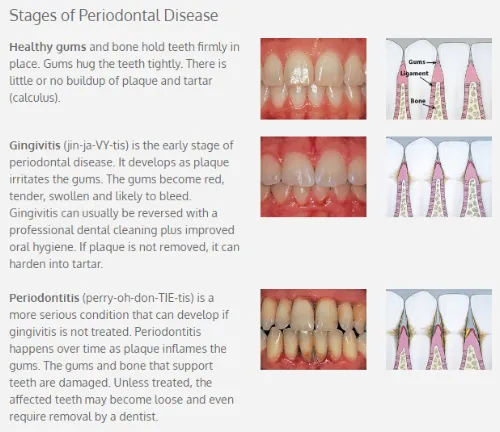
Periodontal Scaling
Periodontal scaling involves removing plaque and tartar
from above and below the gum line.
Periodontal Scaling
Among the causes for periodontal (gum) disease are genetic susceptibility, smoking, and other illnesses like diabetes. Periodontal maintenance involves removing plaque and tartar from above and below the gum line. Most gum diseases are preventable with proper oral hygiene. However, what can start out as gingivitis (inflamed or bleeding gums) can quickly turn into periodontitis. In such cases, gums pull away from the tooth to create “pockets,” thereby exposing a dental root to infection. It can also lead to bad breath, loose teeth, painful chewing and other complications.
Diagnosing Gum Disease
In order to diagnose gum disease, we will do a full dental examination including x-rays. The exam will include periodontal charting where several gum measurements are taken. We will then discuss with you your diagnoses and treatment options. We will also discuss risk factors and preventative measures you can take to stop the progression of gum disease.
Further Treatment
The first line of treatment for gum disease is usually scaling and root planing (deep cleaning). This cleaning often times require numbing since it involves removing plaque and tarter beneath the gum line. After your initial deep cleaning, we will monitor you with periodic gum measurements and oral hygiene checks. We will also recommend a periodontal maintenance interval (usually every 3-4 months). The reason why this interval is more often than a normal 6 month interval is because plaque and tarter need to be removed more frequently in patients who have gum disease. It is also helpful to monitor patients with periodontal disease more closely and to check oral hygiene habits. After a year, we will reevaluate gum
health and determine if a different periodontal maintenance interval is needed. If necessary, we may refer you to a periodontist (gum specialist).

Periodontal Scaling
Among the causes for periodontal (gum) disease are genetic susceptibility, smoking, and other illnesses like diabetes. Periodontal maintenance involves removing plaque and tartar from above and below the gum line. Most gum diseases are preventable with proper oral hygiene. However, what can start out as gingivitis (inflamed or bleeding gums) can quickly turn into periodontitis. In such cases, gums pull away from the tooth to create “pockets,” thereby exposing a dental root to infection. It can also lead to bad breath, loose teeth, painful chewing and other complications.
Diagnosing Gum Disease
In order to diagnose gum disease, we will do a full dental examination including x-rays. The exam will include periodontal charting where several gum measurements are taken. We will then discuss with you your diagnoses and treatment options. We will also discuss risk factors and preventative measures you can take to stop the progression of gum disease.
Further Treatment
The first line of treatment for gum disease is usually scaling and root planing (deep cleaning). This cleaning often times require numbing since it involves removing plaque and tarter beneath the gum line. After your initial deep cleaning, we will monitor you with periodic gum measurements and oral hygiene checks. We will also recommend a periodontal maintenance interval (usually every 3-4 months). The reason why this interval is more often than a normal 6 month interval is because plaque and tarter need to be removed more frequently in patients who have gum disease. It is also helpful to monitor patients with periodontal disease more closely and to check oral hygiene habits. After a year, we will reevaluate gum
health and determine if a different periodontal maintenance interval is needed. If necessary, we may refer you to a periodontist (gum specialist).

Post Address and Mail
Email:
[email protected]
Address
Office:
65 Danbury Road Ridgefield, Connecticut 06877
Get In Touch
Assistance Hours
Mon – Sat 9:00am – 8:00pm
Sunday – CLOSED
Phone Number:
(203) 438-8866
Office:
65 Danbury Road Ridgefield, Connecticut 06877
Call
(203) 438-8866
Email:
[email protected]
Site: ridgefielddentistry.com
